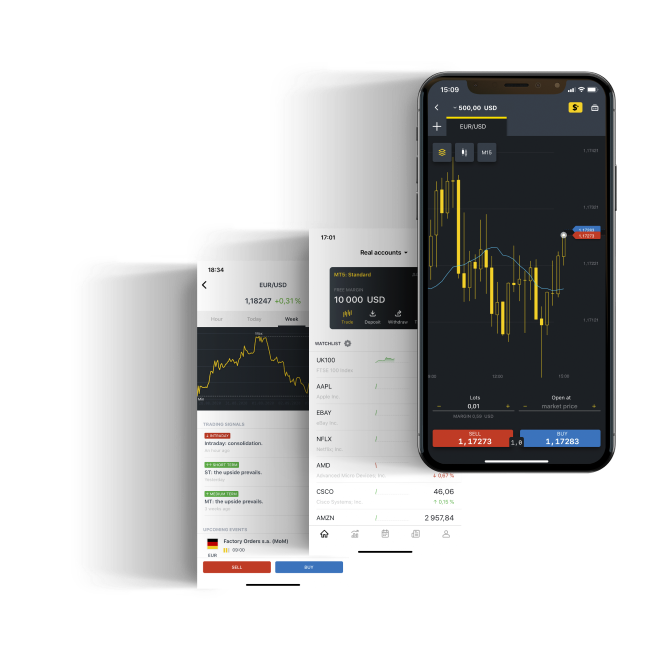Algorithmic and AI trading have changed how traders approach the market. Instead of relying solely on manual chart analysis or emotional decisions, traders can use automated systems to analyze large data sets, detect market patterns, and execute trades with precision. These systems can identify opportunities faster than humans and maintain consistent discipline, especially during volatile periods.
Key Features to Look for in an Algorithmic Trading Platform
Selecting an algorithmic trading system requires more than checking its user interface. Each platform serves different needs depending on a trader’s strategy and coding proficiency. The following are key aspects to evaluate before committing to one.
1. Execution Speed and Stability
Milliseconds can determine profitability in algorithmic trading. Platforms with low-latency infrastructure and direct market access offer better price execution and fewer slippage issues. Stability is also crucial, as system downtime can result in missed opportunities or unintended exposure.
2. Backtesting and Simulation Tools
A robust backtesting engine allows traders to evaluate a strategy’s historical performance using accurate market data. Simulation environments replicate live market conditions, letting users test without financial risk. This helps identify weak points in logic or parameter selection.
3. Programming Language and API Support
Compatibility with common languages like Python, C#, or MQL5 increases flexibility. Many platforms offer APIs for integrating third-party data feeds, order routing, or AI models. A versatile API also supports custom dashboards and risk monitoring systems.

4. Data Quality and Accessibility
Accurate and comprehensive data is essential for algorithmic precision. High-quality tick data, extensive historical records, and access to multiple asset classes (forex, stocks, futures, crypto) improve model reliability.
5. Cost Structure and Commission Transparency
Trading fees directly affect profitability. Evaluate whether the platform charges per trade, per volume, or via subscription. Some brokers include VPS hosting or data feeds at no extra charge, while others require separate contracts.
6. Security and Compliance
Since algorithms often run unattended, account protection is vital. Look for encrypted connections, two-factor authentication, and regulatory adherence from the provider. Compliance with financial authorities ensures the infrastructure meets operational standards.
Core Evaluation Metrics for Algorithmic Platforms
| Feature Category | Key Evaluation Criteria | Importance Level |
| Execution | Latency, reliability, order speed | Critical |
| Development | Coding language, API, IDE tools | High |
| Data Access | Tick data accuracy, range of assets | High |
| Testing | Backtesting engine, simulation quality | High |
| Cost | Spreads, commissions, subscription plans | Medium |
| Security | Encryption, compliance, authentication | Critical |
The optimal platform combines these technical aspects into a cohesive system that matches the trader’s workflow. Scalability is also important — strategies that function well on small accounts should perform consistently when scaled up.
Top Platforms for Algorithmic and AI Trading in 2025
Each trading platform has its advantages depending on execution speed, coding flexibility, and analytical depth. The following systems stand out for their technology stack, community support, and automation capabilities.
MetaTrader 5 (MT5)
MetaTrader 5 remains a leading choice for retail algorithmic traders. It supports multi-asset trading, built-in indicators, and advanced order types. The MQL5 programming language enables the creation of Expert Advisors (EAs) that can handle complex trading logic and portfolio management.
MT5 also offers a robust backtesting module that supports multi-threaded optimization. With integrated VPS hosting, algorithms can run continuously without interruptions. Its marketplace provides thousands of pre-built EAs and indicators, which can be customized or combined with personal code.
MT5 Algorithmic Trading Overview
| Component | Description |
| Language | MQL5 |
| Key Strength | Multi-asset support, community resources |
| Backtesting | Multi-threaded, tick-by-tick |
| Automation | Expert Advisors, custom indicators |
| Suitability | Retail and semi-professional traders |
cTrader Automate
cTrader Automate, formerly cAlgo, focuses on flexibility and precision. Using C# language, it integrates well with Microsoft’s .NET framework, allowing advanced developers to build sophisticated models. The visual backtester helps traders adjust parameters while observing strategy behavior in real-time.
The platform also offers depth of market (DOM) visualization, cloud-hosted bots, and API connectivity for external data analytics. cTrader Automate suits traders seeking a professional-grade environment without excessive complexity.
NinjaTrader
NinjaTrader is favored among professional and quantitative traders who require deep analytical functionality and extensive data control. Its architecture allows both discretionary and fully automated trading across futures, forex, and equities. The platform’s NinjaScript language, based on C#, enables precise customization of trading logic, risk filters, and performance tracking.
NinjaTrader’s backtesting suite offers multi-timeframe testing and walk-forward optimization, ensuring strategies can adapt to changing market conditions. Real-time performance metrics and trade-by-trade analytics help traders assess how algorithms behave under volatility.
A unique benefit of NinjaTrader is its strong community marketplace, where developers publish custom indicators, strategies, and order-flow tools. Combined with direct broker connectivity, it provides professional-grade execution with institutional data feeds.
QuantConnect
QuantConnect operates as a cloud-based quantitative research and trading environment. Built on the open-source Lean engine, it supports multiple asset classes — equities, futures, forex, options, and crypto. Users can develop strategies in Python or C#, run backtests using institutional-quality data, and deploy live strategies through broker integrations.
One of QuantConnect’s core advantages is access to its collaborative data library. Traders can use alternative datasets such as fundamentals, options chains, and sentiment metrics. The cloud infrastructure supports large-scale computations, allowing backtests covering years of tick-level data in minutes.
QuantConnect is especially appealing for data scientists and algorithmic researchers seeking flexibility, scalability, and transparent infrastructure.
QuantConnect Key Specifications
| Category | Details |
| Languages | Python, C# |
| Infrastructure | Cloud-based Lean engine |
| Assets | Equities, forex, futures, options, crypto |
| Strength | Data library, scalability, open-source model |
| Ideal User | Quantitative analysts and advanced traders |
TradeStation
TradeStation combines traditional brokerage services with advanced automation and analytics. Its proprietary EasyLanguage scripting system allows traders to create, test, and automate strategies without requiring extensive programming skills. The platform supports equities, ETFs, options, and futures, making it suitable for diversified portfolios.
The backtesting system is integrated with the RadarScreen tool, which tracks real-time market data and alerts traders when conditions match predefined criteria. Additionally, TradeStation provides extensive historical databases and pattern recognition tools, useful for developing machine learning-driven models.
Its broker integration ensures fast order routing and execution reliability, backed by professional-grade risk management modules.

How to Choose the Right Platform for Your Strategy
The best choice depends on trading objectives, coding proficiency, and preferred markets. Retail traders may prefer user-friendly solutions such as MT5 or cTrader Automate, while quantitative analysts often gravitate toward QuantConnect or NinjaTrader due to their data depth and coding flexibility.
To simplify the selection process, consider the following checklist:
- Assess Technical Skills: Beginners may focus on visual editors and pre-built bots. Advanced users can explore platforms supporting Python or C#.
- Evaluate Market Access: Choose systems compatible with your asset classes — forex, indices, or crypto.
- Check Data Availability: Reliable historical and tick data improve backtesting precision.
- Compare Costs: Analyze spreads, subscription fees, and additional hosting expenses.
- Test Scalability: Start small, then evaluate how the infrastructure performs under heavier trading volume.
AI Tools Commonly Used in Trading
Artificial intelligence continues to redefine algorithmic trading by allowing systems to learn and adapt over time. Unlike static rule-based bots, AI-driven strategies can recognize evolving market behaviors and adjust accordingly. The three main approaches include machine learning, natural language processing, and reinforcement learning.
Machine Learning Algorithms for Market Prediction
Machine learning models process historical and real-time data to forecast probable market directions. Regression models, decision trees, and neural networks are often used to predict asset prices, volatility, or volume surges.
Supervised learning helps identify relationships between indicators and price movements, while unsupervised techniques such as clustering reveal hidden patterns in data. Gradient boosting and ensemble methods are frequently applied for portfolio optimization and risk scoring.
These algorithms are especially useful when combined with feature engineering, where variables such as momentum, sentiment, or macroeconomic indicators are refined for predictive accuracy.
Natural Language Processing for News and Sentiment Analysis
Natural Language Processing (NLP) enables algorithms to interpret text data from news, reports, and social media. Models evaluate sentiment polarity — positive, neutral, or negative — and quantify how it might affect asset pricing.
For instance, a sudden spike in negative sentiment around a company may signal short-term price pressure. NLP models use tokenization, named entity recognition, and transformer-based architectures like BERT to process unstructured text efficiently.
This approach enhances short-term trading signals by integrating qualitative insights with quantitative models.
Reinforcement Learning in Automated Systems
Reinforcement learning (RL) models make trading decisions through trial and reward feedback. Instead of following fixed rules, these systems learn optimal strategies by interacting with simulated or live markets. Each trade outcome provides a signal to improve decision-making over time.
RL techniques such as Deep Q-Networks (DQN) and Proximal Policy Optimization (PPO) have shown success in high-frequency trading and hedging models. They adjust to changing liquidity and volatility, optimizing execution across multiple instruments.
Risks and Limitations of Algorithmic and AI Trading
While automation offers precision and speed, it also introduces unique vulnerabilities that manual traders rarely face. Understanding these risks is essential before deploying any live strategy.
- Overfitting in Backtesting: Many algorithms perform exceptionally well during historical testing but fail in live markets. This happens when models are tuned too closely to past data patterns that may not repeat. Traders should validate strategies with out-of-sample testing and walk-forward analysis to reduce this risk.
- Data Quality and Latency Issues: AI systems depend entirely on data accuracy. Delayed or incorrect data can trigger false signals and unplanned orders. Using premium data providers and low-latency connections reduces exposure to execution mismatches.
- Model Drift and Market Changes: Over time, economic conditions, liquidity, and volatility evolve. A model trained on outdated data might lose predictive power. Continuous retraining with recent data ensures relevance.
- Technical Failures and Infrastructure Risk: Power outages, internet disconnections, or server downtime can disrupt trading. Reliable VPS services, cloud infrastructure, and failover systems are critical for uninterrupted performance.
- Regulatory and Compliance Constraints: Certain jurisdictions impose restrictions on automated trading frequency, leverage, or API use. Compliance monitoring and proper broker authorization prevent legal complications.
Tips for Getting Started with Algorithmic and AI Trading
Transitioning from manual to automated trading requires structured preparation. The following practical steps can accelerate learning and reduce costly mistakes.
- Begin with a Clear Objective: Define what the strategy should achieve — short-term scalping, trend following, or statistical arbitrage. Each goal demands a different design and execution approach.
- Start with Simulated Trading: Before deploying real capital, test algorithms in demo or paper accounts. Observe how the system handles execution delays, spread changes, and slippage.
- Use Simple Strategies Initially: Complex models increase debugging difficulty. Start with single-indicator triggers or basic moving average crossovers, then progress to AI-driven logic once stability is confirmed.
- Integrate Proper Risk Controls: Set stop-loss and take-profit parameters within the code. Adding dynamic position sizing and maximum drawdown limits protects against unexpected volatility.
- Monitor and Update Regularly: Even successful algorithms degrade over time. Review logs, performance metrics, and market behavior to make timely adjustments.
- Learn from Historical Data: Download and analyze tick data for multiple timeframes. Identify recurring volatility patterns that align with your trading style.
Frequently Asked Questions
Which algorithmic trading platform is best for beginners?
MetaTrader 5 and cTrader Automate are often preferred by newcomers due to intuitive interfaces, built-in scripting tools, and large online communities.


